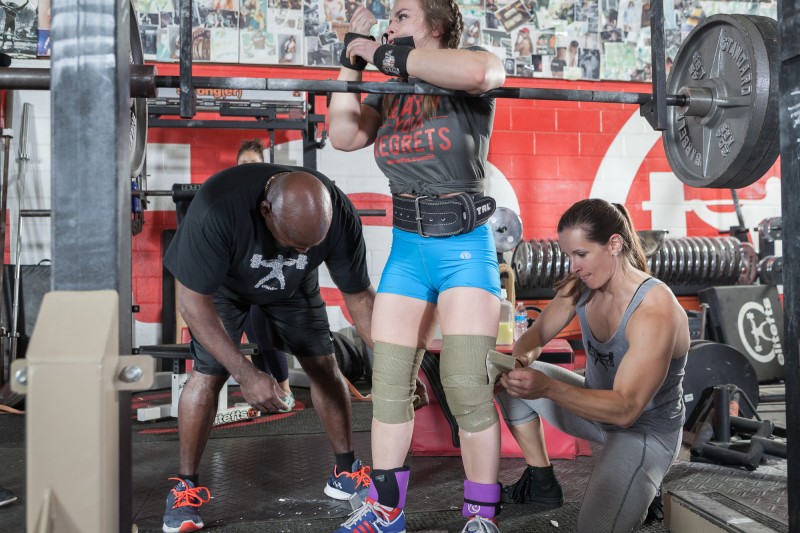
I was lifting a heavy box from a high shelf when the metal rack reared its teeth and bit me, slicing the middle finger of my right hand. The wound was deep. I was working as a commercial mover for college spending money. The incident was one of many that shaped that summer.
"Shit," I said, turning toward one of my coworkers, my blood-splattered hand upturned in the inverse of a claw. "This is going to need stitches.” I don't have time for stitches.
Three hours later the doctor at the emergency clinic had it cleaned, stitched, and bandaged. I headed home for dinner and planned to be off to the gym.
RELATED: How to Make Money as a Personal Trainer
"You're not training tonight," my mother said. "You just got stitches."
"I can't miss, Mom," I said. "Don't worry; I will be careful." I hopped from the table and tossed my dishes in the sink. I slapped my mom with a kiss on the cheek, hopped in my orange 1973 Volkswagen Beetle, and was off to the gym for upper body training. I was prepared to bench with my injured pointer finger extended toward the sky — and my middle finger extended toward anyone suggesting I should take the night off.
I was seventeen-years-old and I loved to train. Still do.
I now understand that not everyone feels similarly toward intense training. Inarguably, it requires hard work to produce results, and often a trainee needs someone to both motivate and instruct, which is where a good trainer is an invaluable asset.

Training and Programming — Providing Something of Value
In 2010, as part of a much larger story, I became a Certified Strength and Conditioning Specialist (CSCS) with the National Strength and Conditioning Association. The CSCS is a prominent certification. It is both challenging to obtain (it is one of a few that require a college degree) and a great asset for anyone planning to train collegiate athletes. That said, the lion’s share of my training knowledge was obtained under the bar over more than thirty years of trial and error.
Throughout high school and college, I had always trained my friends and provided them with my thoughts on programming. In 2010, for the first time, I was providing this service for compensation; I had started formally training clients.
Initially, accepting money for providing this service felt strange. I was getting paid to do something I loved. I was receiving compensation for spending time in an environment I relished. Eventually, I realized I was providing an important service. My knowledge and experience provided quantifiable value. I became comfortable receiving compensation for my efforts, and my clients were achieving excellent results. Additionally, I came to realize that the process doesn't work well without compensation and seldom does it work at all.
Trainers cannot work for free — the imbalance creates an unsustainable state.
Trainee Not Vested
To gain experience with female trainees, I had initially offered to train a friend for free. She had expressed the desire to lose weight and concurrently increase her strength and muscularity. It was the perfect opportunity, or so I thought.
I had the facility in which to train and advised her I was prepared to begin the training any time she was ready. Together we completed a total of zero sessions. Zero. She could never muster the motivation to get to the facility. Part of the problem, I'm convinced, was that she had no real skin in the game. Without a strong desire to train, it was too easy for her to cancel.
Unfortunately, I have encountered similar experiences multiple times. In situations where I had offered to train someone without compensation (for a variety of reasons), the result was frequently a late arrival, a postponement, or a full cancellation. After scheduling a training session for Friday at 7 PM, I would inevitably receive a text at 6:45: "Can we move the training to 7:30?" No!
Without a deep love for training and/or significant and consistent internal motivation to achieve the desired result, most trainees need additional external motivation, which can be catalyzed by the trainer’s compensation.
Trainer Not Vested
In all candor, the compensation issue cuts both ways. We all have priorities and a limited amount of time to tackle our daily, weekly, and monthly responsibilities. As a trainer, if I am working for free, it's also much easier to cancel or arrive at a session less prepared than I should be. It's easy to rationalize, and inevitably, I am going to either prioritize paying clients or other activities consistent with achieving other goals.
As diligent and conscientious as I am, I’ve found that training for free is an unsustainable state. The situation often crumbles, leaving both parties feeling disappointed.
The Exception
Training offered in certain charitable situations is the one exception I have found that definitely works. In my case, this is particularly true when young athletes are involved, as I am too conscientious to disappoint those in genuine need.
We were training some inner-city football players at one point in my Connecticut facility. I had made a deal with their football coach: you get them here, and we will train them. Collectively, we could muster one gathering per week, so we were forced to appropriate a tremendous amount of work into that individual session. It felt good.
My trainers and I knew we were making a difference in these young men's lives. The feeling of doing something for the community outweighed the need for compensation. We took tremendous pride in the work and the outcome.
In Summary
While training clients without compensation, in my experience, is generally unsustainable over the long term, I have found at least one exception. For me, it was a charitable circumstance involving young athletes. For you, the situation and your level of motivation may be different.
As a trainer, remember you are providing a valuable service that functions best in a mutually beneficial situation.











